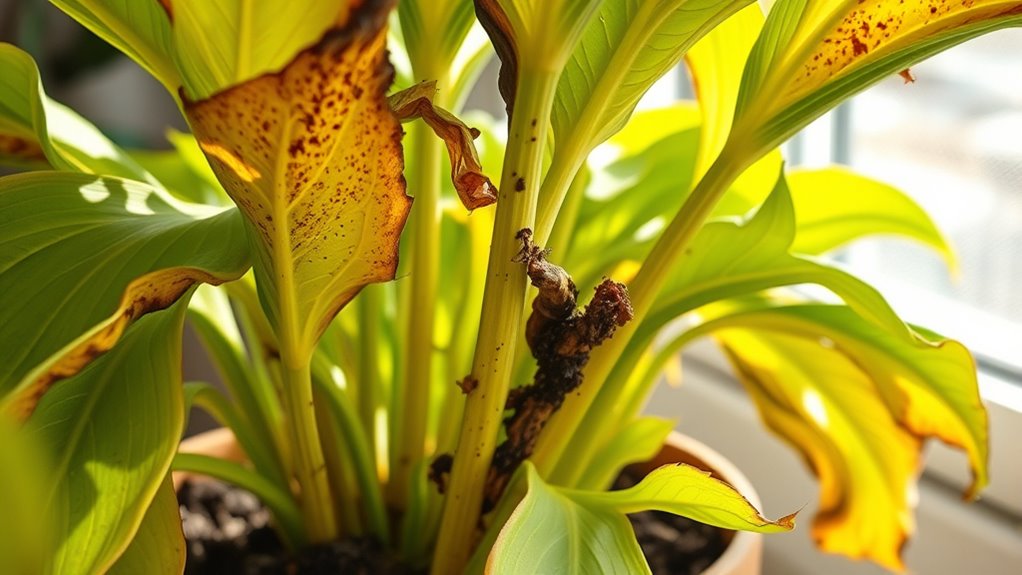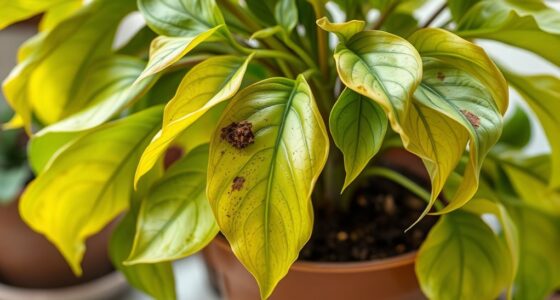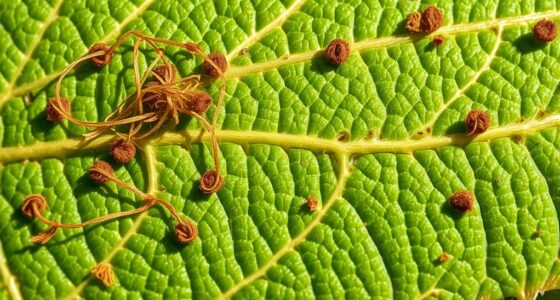If your plant is struggling, look for signs like wilting, dry or crispy leaves, yellowing, spots, or webbing—these can point to watering problems, pests, or nutrient issues. Overwatering causes root rot, while underwatering leads to dehydration. Pests like aphids or spider mites leave sticky residue or webbing, and nutrient deficiencies may cause discoloration. Regularly inspecting your plant helps catch these issues early. Keep an eye out to learn how to fix these common problems effectively.
Key Takeaways
- Observe leaf color, spots, or wilting to identify pests, diseases, or nutrient deficiencies early.
- Check soil moisture to determine overwatering or underwatering issues affecting plant health.
- Look for sticky residue, webbing, or insects on leaves and stems as signs of pest infestation.
- Notice dry, crispy edges or brown tips indicating dehydration or low humidity problems.
- Regularly inspect your plant for changes in appearance to catch problems early and adjust care accordingly.

Plants can develop a variety of problems that affect their health and appearance, but many issues are easy to identify once you know what to look for. One of the most common causes of plant health problems stems from watering issues. If your plant’s leaves are yellowing or wilting despite recent watering, you might be overwatering or underwatering. Overwatering often leads to root rot, which prevents the roots from absorbing nutrients properly, causing leaves to turn yellow, become soft, or drop prematurely. On the other hand, underwatering leaves your plant dehydrated, resulting in dry, crispy edges or drooping foliage. To diagnose watering issues, check the soil moisture by feeling the top inch; if it’s soggy, hold off on watering, and if it’s bone dry, give your plant a thorough soak. Adjust your watering schedule accordingly, ensuring you’re providing consistent moisture without drowning the roots.
Overwatering causes root rot; underwatering leads to dehydration—check soil moisture to keep your plants healthy.
Another key aspect of diagnosing plant problems involves pest identification. Pests can be tiny, almost invisible, or large enough to be seen crawling on the leaves or stems. Common pests include aphids, spider mites, mealybugs, and scale insects. Look closely at the undersides of leaves and along stems for signs of pests, such as sticky residue, webbing, or small insects. Pest infestations often cause distorted or discolored leaves, speckled or stippled foliage, or a general decline in the plant’s vigor. If you spot pests, act quickly by gently removing them with a soft cloth or spray, or use an appropriate insecticidal soap to eliminate the problem. Regular inspections help catch pests early before they spread or cause severe damage.
Other issues may not be immediately visible but can be diagnosed through careful observation. For example, yellowing leaves can also indicate nutrient deficiencies, while brown tips might result from low humidity or over-fertilization. Spotting these signs early allows you to adjust your care routine — whether that’s improving airflow, increasing humidity, or fertilizing appropriately. Additionally, understanding the importance of vaccinations for pets can be a helpful analogy—just as plants need proper care and protection, pets require vaccinations to stay healthy and prevent disease.
Ultimately, understanding the common signs of watering issues and pest identification equips you to troubleshoot your plant’s problems effectively. Regularly inspecting your plants, paying attention to their watering needs, and being vigilant for pests can save you time, money, and frustration. When you catch issues early, you give your plants the best chance to recover and thrive. With patience and attentive care, you’ll develop a keen eye for diagnosing problems and keep your plants healthy and beautiful for years to come.
Frequently Asked Questions
How Often Should I Water My Plant?
To determine how often you should water your plant, consider its specific watering schedule and moisture levels. Most plants prefer the top inch of soil to dry out between waterings, so check moisture levels regularly. Adjust your watering frequency based on the plant’s needs, environmental conditions, and season. Typically, watering once a week works for many, but always make certain excess water drains properly to prevent root rot.
What Soil Is Best for My Plant Type?
Choosing the right soil is like finding the perfect recipe for success. You need to take into account soil composition and pH levels to match your plant’s needs. For most plants, well-draining soil rich in organic matter works best, with a pH between 6.0 and 7.0. Check your plant’s specific requirements, and adjust the soil accordingly. This helps guarantee healthy growth and vibrant foliage, just like a well-balanced diet nurtures your body.
How Do I Identify Pest Infestations Early?
To identify pest infestations early, stay vigilant with pest identification and regular inspections. Look for tiny insects, webbing, discolored or damaged leaves, and sticky residue. Check undersides of leaves and stems often, as pests hide there. The sooner you detect these signs, the easier it is to control the problem. Consistent monitoring and prompt action help prevent minor issues from becoming major infestations.
When Should I Repot My Plant?
You should repot your plant when it becomes root bound, meaning roots circle tightly and outgrow the pot. This often causes nutrient deficiency since roots can’t absorb enough nutrients. If you notice slowed growth, wilting, or water drains quickly, it’s time to repot. Choose a slightly larger pot with fresh soil to give roots room to expand and access essential nutrients, ensuring your plant stays healthy and vigorous.
What Are Natural Remedies for Plant Diseases?
You can try natural remedies for plant diseases with organic treatments and homemade cures. For fungal issues, sprinkle cinnamon or neem oil on affected areas. Use diluted baking soda spray for powdery mildew, and apply garlic or onion extracts as natural fungicides. These organic treatments are eco-friendly and safe for your plants, helping to combat common problems without harsh chemicals. Regular monitoring and early intervention boost your plant’s health naturally.
Conclusion
Now that you know these signs, you’re practically a plant doctor in disguise! Spotting issues early can save your plant from turning into a dried-up husk faster than you can say “photosynthesis.” Remember, your plant’s health is in your hands—like a superhero with a green thumb. Keep a close eye, diagnose quickly, and you’ll turn that struggling plant into a thriving jungle in no time. Your green oasis awaits—go conquer it!









